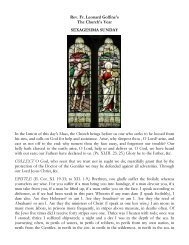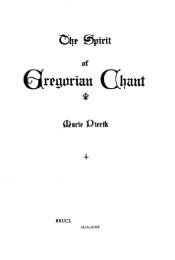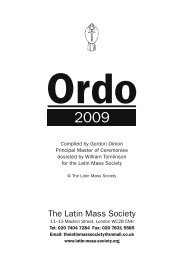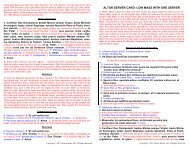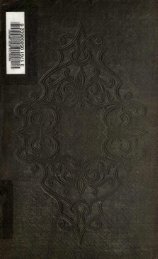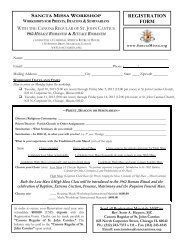LEARNING THE MASS - SanctaMissa.org
LEARNING THE MASS - SanctaMissa.org
LEARNING THE MASS - SanctaMissa.org
You also want an ePaper? Increase the reach of your titles
YUMPU automatically turns print PDFs into web optimized ePapers that Google loves.
Making a medium bow 38 and<br />
holding your hands joined between your<br />
breast and the altar (not on the altar),<br />
recite the Agnus Dei in the loud tone.<br />
After the word mundi place your left<br />
hand on the corporal, palm downward,<br />
and strike your breast with the tips of the<br />
last three fingers of your right hand at<br />
miserere nobis. Strike your breast<br />
again 39 at the repetition of Miserere<br />
nobis and again at dona nobis pacem. 40<br />
A<br />
gnus Deí, qui tollis peccáta<br />
mundi: miserére nobis.<br />
Agnus Dei, qui tollis<br />
peccáta mundi: miserére nobis.<br />
Agnus Dei, qui tollis<br />
peccáta mundi: dona nobis pacem.<br />
Still bowing as before (medium<br />
bow), join your hands and rest them on<br />
the edge of the altar in front of the<br />
corporal. Keeping your eyes intent upon<br />
the Host, say the three Communion<br />
prayers. 41<br />
D<br />
ómine Jesu Christe, qui<br />
dixísti Apóstolis tuis:<br />
pacem relínquo vobis, pacem<br />
meam do vobis: ne respícias<br />
peccáta mea, sed fidem Ecclésiae<br />
tuae; eámque secúndum<br />
voluntátem tuam pacificáre et<br />
coadunáre dignéris: Qui vivis et<br />
regnas Deus per ómnia saécula<br />
saeculórum. Amen.<br />
38 Rit. Cel., X, 2 says: capite inclinato versus<br />
Sacramentum. The rubric in the text itself says:<br />
inclinatus Sacramento. Most authors prescribe a<br />
medium (body) bow.<br />
39 Some authors say that the right hand should be<br />
placed on the corporal after striking the breast<br />
the first and second times (not, however, before<br />
striking the breast the first time). Other authors<br />
say that the right hand should not be placed on<br />
the corporal but should be moved back and forth<br />
slowly between the breast and the corporal. The<br />
same difference of opinion holds with regard to<br />
the Domine, non sum dignus. In practice either<br />
opinion may be followed.<br />
40 In a Requiem Mass the priest substitutes dona<br />
eis requiem for miserere nobis, and dona eis<br />
requiem sempiternam for dona nobis pacem. He<br />
keeps his hands joined and does not strike his<br />
breast; Callewaert, p. 104, says that the reason he<br />
does not strike his breast is that he is praying for<br />
others, not for himself.<br />
41 The first of these three prayers is omitted in<br />
Requiem Masses.<br />
D<br />
ómine Jesu Christe, Fili Dei<br />
vivi, qui ex voluntáte<br />
Patris, cooperánte Spíritu Sancto,<br />
per mortem tuam mundum<br />
vivificásti: líbera me per hoc<br />
sacrosánctum Corpus et Sánguinem<br />
tuum ab omnibus<br />
iniquitátibus meis, et universis<br />
malis: et fac me tuis semper<br />
inhaerére mandates, et a te<br />
numquam separári permíttas: Qui<br />
cum eódem Deo Patre et Spíritu<br />
Sancto vivis et regnas Deus in<br />
saécula saeculórum. Amen.<br />
43




